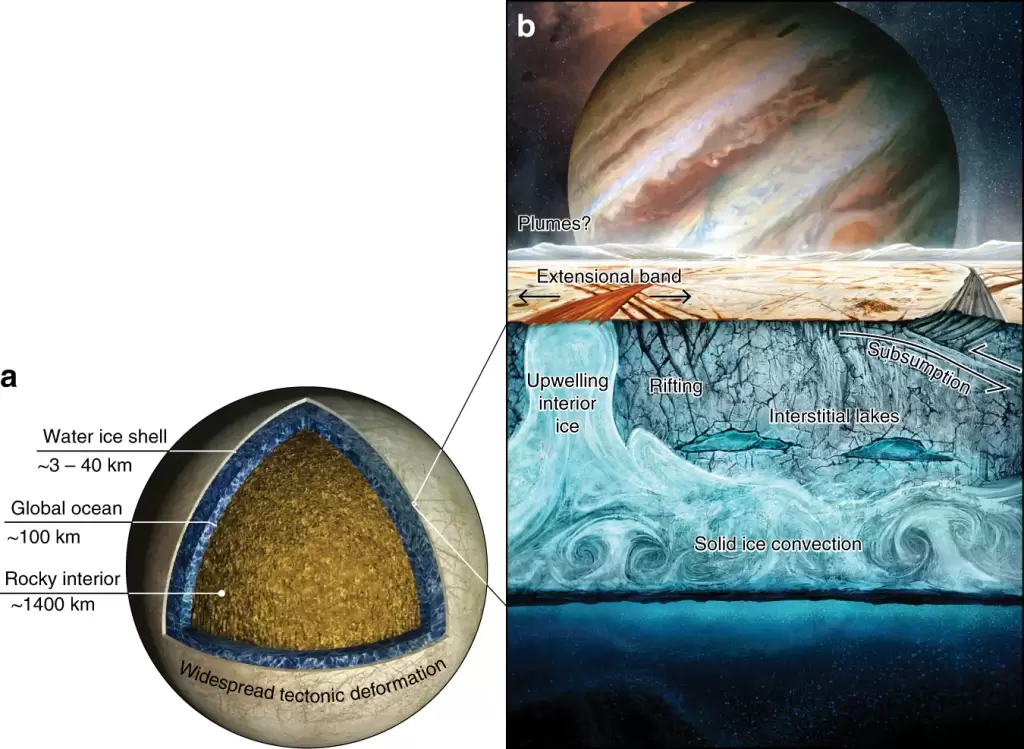IAP-25-106
Eruptive Brines and Active Ice: Modelling Subduction, Brine Dynamics and Cryovolcanism on Jupiter’s Icy Moon Europa
Jupiter’s icy moon Europa is one of the most compelling targets for planetary science and astrobiology. Its young surface is crisscrossed by bands, ridges, pits, domes and chaos terrains, features that suggest an active ice shell undergoing processes potentially similar to plate-like tectonics on Earth (Figure 1, Sullivan et al., 1998; Tufts et al., 2000; Howell & Pappalardo, 2019). This together with evidence of plume like activity indicates that cryovolcanism i.e., the ascent and eruption of briny water or ice melts might play a central role in resurfacing Europa, contributing to the exchange of oxidants and reductants between surface and ocean, and sustaining potential habitability (Vance, 2018; Soderlund et al., 2020).
Several mechanisms have been proposed to explain how cryovolcanism initiates (Figure 1). One possibility is that surface ice slabs are recycled downwards by subduction-like processes, where they may release brines back into the shell (Howell & Pappalardo, 2019). Another is that salt segregation during solidification form brine lenses that persist and destabilise, driving the formation of chaos terrains or transient flows (Buffo et al., 2021). Heat and buoyant material arising from the underlying ocean, may also promote melting at the base of the ice shell sustaining plume activity (Soderlund et al., 2020). Together these pathways are further influenced by tidal heating (Tobie et al., 2025) and the complex thermophysical of ice–brine mixtures.
Despite substantial progress in understanding the mechanisms that drive cryovolcanism and broader icy moon dynamics, most studies have examined these processes in isolation. What remains lacking is an integrated framework that can quantify their relative contributions, interactions, and observable signatures. This project seeks to fill that gap by addressing the following central questions:
1. Under what conditions can subducting ice slabs warm and contribute to cryovolcanic activity?
2. How do mushy-layer physics and salt segregation promote the formation, persistence, and destabilisation of brine-rich zones?
3. To what extent can boundary conditions derived from ocean circulation models influence ice shell convection and melting dynamics?
4. What observable signatures (e.g., radar anomalies, surface morphologies, or thermal hotspots) would these processes produce, and could they be detected by the recently launched Europa Clipper mission (Pappalardo et al., 2024; Daubar et al., 2024)?
By combining tectonics, brine dynamics, and ice–ocean boundary interactions within one modelling framework, this project will investigate the initiation and style of cryovolcanism on Europa. This is especially critical in light of forthcoming mission data from NASA’s Europa Clipper mission and is crucial in advancing our understanding of icy world dynamics and their potential habitability.

Click on an image to expand
Image Captions
Figure 1. Conceptual model of Europa’s ice shell and ocean dynamics, showing subduction, brine storage, convective upwellings, and possible surface plumes (adapted from Howell & Pappalardo, 2020).
Methodology
The student will build coupled thermo-mechanical models of Europa’s ice shell using the open-source finite-element geodynamics code ASPECT (Heister et al., 2017). The modelling will include:
• Thin-shell tectonics and subduction with visco-elasto-plastic rheology, incorporating tidal dissipation as a heat source (Tobie et al., 2025).
• Brine migration and mushy-layer physics, capturing how salt segregation and multiphase processes can create and destabilize brine-rich zones (Buffo et al., 2021).
• Application of boundary conditions derived from ocean circulation models to represent the influence of ocean-driven processes on ice shell dynamics (Soderlund et al., 2020).
• Generation of model observables (e.g., topography, thermal signatures) for comparison with Europa Clipper datasets (Pappalardo et al., 2024; Becker et al., 2024).
Project Timeline
Year 1
Literature review; familiarisation with C++, ASPECT, and high-performance computing; reproduce benchmark geodynamic models; initial ice-shell-only thermo-mechanical models.
Year 2
Implement brine physics (mushy-layer parameterisations, brine lens dynamics); test subduction and melting scenarios; prepare first publication.
Year 3
Integrate tidal heating and ocean boundary condition effects; generate synthetic observables for Europa Clipper comparison; submit second paper.
Year 3.5
Consolidate results; comparative planetology analysis; final paper, thesis writing and conference dissemination.
Training
& Skills
• Scientific skills: Geodynamic modelling, planetary geophysics, brine dynamic
• Technical skills: HPC, numerical modelling with ASPECT, coding in Python/C++, data analysis, visualisation.
• Transferable skills: Scientific writing, conference presentation, interdisciplinary collaboration, public outreach, project/time management.
• Career development: The student will be trained for careers in planetary science and exploration, computational geophysics, and Earth/ocean sciences, with strong cross-disciplinary applications.
References & further reading
• Buffo, J. et al., 2021. Characterizing the ice-ocean interface of icy worlds: a theoretical approach. Icarus.
• Daubar, I. J., Hayes, A. G., Collins, G. C., Craft, K. L., Rathbun, J. A., Spencer, J. R., Wyrick, D. Y., Bland, M. T., Davies, A. G., Ernst, C. M., Howell, S. M., Leonard, E. J., McEwen, A. S., Moore, J. M., Phillips, C. B., Prockter, L. M., Quick, L. C., Scully, J. E. C., Soderblom, J. M., … Pappalardo, R. (2024). Planned Geological Investigations of the Europa Clipper Mission. Space Science Reviews, 220(1). https://doi.org/10.1007/s11214-023-01036-z
• Howell, S. & Pappalardo, R., 2019. Europa-style plate tectonics: extension, convection and the fate of icy slabs. JGR Planets.
• Howell, S. & Pappalardo, R., 2020. Tectonic activity and habitability on Europa. Nature Communications, 11, 1311. https://doi.org/10.1038/s41467-020-15160-9
• Pappalardo, R. et al., 2024. Science overview of the Europa Clipper Mission. Space Science Reviews.
• Soderlund, K. et al., 2020. Ice-ocean exchange processes in the Jovian and Saturnian satellites. Space Sci Rev.
• Sullivan, R. et al., 1998. Episodic plate separation and fracture infill on the surface of Europa. Nature.
• Tufts, B. et al., 2000. Lithospheric dilation on Europa. Icarus.
• Tobie, G. et al., 2025. Tidal deformation and dissipation processes in icy worlds. Space Science Reviews.
• Vance, S. D. (2018). The Habitability of Icy Ocean Worlds in the Solar System. In Handbook of Exoplanets (pp. 1–23). Springer International Publishing. https://doi.org/10.1007/978-3-319-30648-3_63-1

